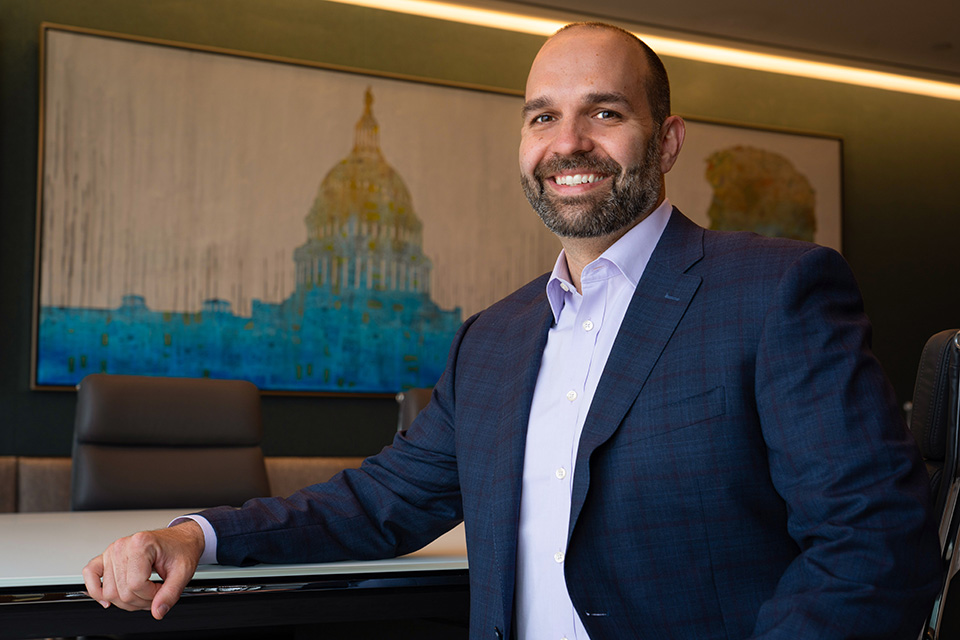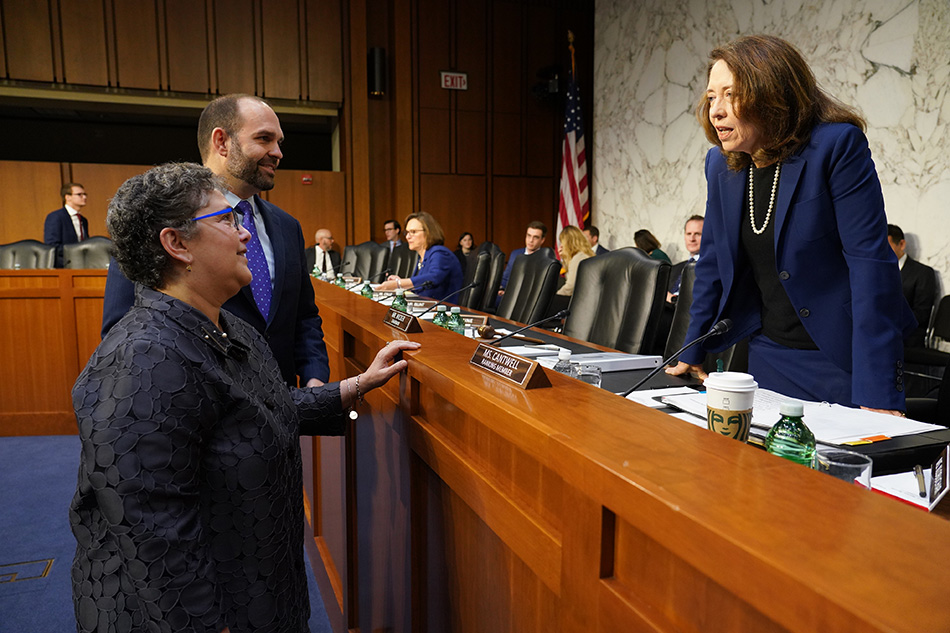Curtis LeGeyt Preps NAB’s Post-Pandemic Policy Agenda
Collaboration is the watchword for incoming chief of broadcast’s top trade group

Two words recur frequently during a discussion with Curtis LeGeyt, the next president and CEO of the National Association of Broadcasters. They describe
his operating vision: “bipartisan” and “collaborative.”
He also peppers conversations with media buzzwords — especially “disruptive” and “diversity” — reflecting the challenges that face an industry now buffeted by technology, pandemic economics and shifting demographics.
LeGeyt (pronounced Le-JET), who has been on the NAB staff since 2011, mostly as a senior government relations executive, became NAB’s chief operating officer about a year ago. He will take over the top spot on Jan. 1, 2022, from Gordon Smith, who has held the post since 2009. LeGeyt believes the continuity from Smith to him will assure NAB’s ability to handle its swath of priorities, ranging from retransmission consent policies, spectrum usage and local journalism to ownership, ad tax and performance tax decisions.
“We approach advocacy from a bipartisan perspective,” he said.
LeGeyt sees a “nexus between journalism, ownership and tech competition,” which he cited as three major “interrelated” factors affecting the broadcasting industry.
“We hope Congress and the Federal Communications Commission understand the disruption” that these developments are causing, LeGeyt said during a telephone interview shortly after NAB revealed the succession plan in early April. He focused on the role that “local broadcasters have as gatekeepers for local audiences” compared to global technology providers.
LeGeyt also emphasized the need to “make sure that advertisers understand local broadcasters” can reach customers in better ways than online systems.
Broadcasting & Cable Newsletter
The smarter way to stay on top of broadcasting and cable industry. Sign up below
He said “one of the great silver linings” of the pandemic period was the “renewed appreciation that local broadcasters can provide information about local businesses, schools, vaccine status” and other community needs. LeGeyt affirmed plans to collaborate with the News Media Alliance (once known as the Newspaper Association of America ) to show policymakers the value of local media.
Citing April’s Supreme Court decision on broadcast ownership rules, LeGeyt said “we’re going to pull every thread to create a policy landscape” that appreciates “how much investment it takes to create a local news product” — a service global tech companies cannot provide, he contended.
Newspapers and broadcasters may have different business practices, LeGeyt added, but when it comes to the impact of local news, “our interests converge.”
“We both see a large part of our audience access or content on digital platforms,” he acknowledged, and the goal is not to stop the tech companies. But he wants to make sure that legislators and regulators remain aware of the importance of local sources. “The good news is that policymakers are extremely focused on this issue,” he said.
LeGeyt sees NAB’s role as making sure that the industries work together to maintain that awareness and support.
First Democrat in 60 Years
LeGeyt’s decade at NAB has solidified his perception of broadcasting’s role in the evolving media landscape.
“You have a hyper-partisan cable news and digital ecosystem,” he said, acknowledging “a lot of distrust of media at large.”
“Our stations are emerging out of that,” LeGeyt explained, because audiences know that “local broadcasters are in the community.” Viewers and listeners “appreciate that,” he said.
LeGeyt came to NAB from the staff of Sen. Patrick Leahy (D-Vt.). He’s the first Democrat to head the association since former Florida Sen. and Gov. LeRoy Collins held the post in the early 1960s. (Smith is a former Republican U.S. Senator from Oregon.) LeGeyt is only the sixth NAB president during six decades.
LeGeyt was attracted to join NAB a decade ago because of his background in antitrust and copyright law, after an undergraduate education in economics.
“The opportunity to leverage that background for an industry that is a cornerstone of American democracy was the real appeal,” LeGeyt recalled. “There is no place where you sit at the intersection of so many issues that are so disruptive but are so critical.”
“That’s what brought me to NAB in the first place. That’s the evolution in the time I’ve been here,” he added.
NAB did not run a traditional search committee process to select LeGeyt as its next president. He called his selection an “affirmation” of satisfaction for his work with Smith during the past decade and the value of continuity of leadership. He cited a nonpartisan ability to leverage relationships with lawmakers.
Smith’s contract as president ran through 2023; he will become a senior adviser to the association for three more years (through 2024), available to help with “bipartisan advocacy,” LeGeyt said. Smith plans to return to his Oregon home to help run the family food processing business and other projects but will be available for D.C. duties when needed.
Although NAB has not revealed LeGeyt’s pay package, it is believed to match Smith’s compensation. According to CEO Update, which tracks association executive salaries, Smith’s recent annual base salary was just above $2 million, with bonuses and perks bringing his total paycheck to about $2.27 million per year.
Mixing Economics, Tech and Policy
The impact of streaming media is high on LeGeyt’s issues agenda, citing its disruptive impact.
“We need to be where consumers are,” he said. “Since viewers increasingly consume via streaming, we need to be accessible wherever and however they want us.”
LeGeyt said part of his immediate mission is explaining the ways the pandemic has reshaped the media landscape to policymakers.
“Ad dollars for broadcasters were tremendously stressed,” he said. “That exposed some key elements of whom we’re competing against. It added a sense of urgency, the need to confront the tech disruption.

“The most important thing we need to do is make sure that lawmakers understand clearly what broadcasters are facing, especially in the competition for ad dollars,” he said. “We want to make sure lawmakers understand the challenge in this entire process,” emphasizing the “challenge to remain forward-looking” to anticipate evolving technical platforms.
That’s where NextGen TV, or ATSC 3.0, also high on LeGeyt’s agenda, comes in. He said it will “assure that our station groups can invest in new tech, which is key to providing service.”
Convention Plans And Personal Life
As for NAB’s near-term agenda, LeGeyt followed up on recent explanations about the October plans for the NAB Show in Las Vegas. NAB executive VP of business operations Chris Brown (who heads convention activities) recently laid out expectations for attendance at about 70% of 2019 levels and about 600 exhibitors (compared to more than 1,000 in April 2019).
“We’re bullish about the October convention,” LeGeyt said. “The demand is there. We’re hearing from members and exhibitors who are yearning to be back in person.” The combined convention will include NAB’s Radio Show and its Sales and Management Television Exchange simultaneously.
“We’re getting feedback that it is efficient for exhibitors and members, for programming all in one place,” LeGeyt explained. He predicts this model “will be a successful one for this year when budgets are tight.”
As LeGeyt navigates the leadership transition, he can look out to the U.S. Capitol from his office in the new NAB Building on South Capitol Street. Although the building is near Nationals Park, he and fellow staff members have to go up to the roof to catch a glimpse of the baseball field. And although he admits becoming a fan of D.C. teams during his decades in Washington, the heart and soul of this Connecticut native is still with New England sports teams.
“There’s nothing quite like Boston sports,” he said with a smile.
At the same time he is preparing NAB’s agenda, LeGeyt and his family (including three kids under 8 years old), are getting ready to move from suburban Alexandria, Virginia, into Washington, D.C. He is involved with several music-related charities, including “Tracy’s Kids” (a music and arts program for childhood cancer support), Musicians on Call (which delivers music programs to patients); he and his wife also support mental health charities.
LeGeyt’s philanthropic efforts reflect his NAB agenda, which as he put it, involves “a passion for what we do.” For his day job as broadcasting’s chief cheerleader, LeGeyt said he “wants to beat the drum” and “assure that policies are in place” to assure broadcasters a steady future.
Contributor Gary Arlen is known for his insights into the convergence of media, telecom, content and technology. Gary was founder/editor/publisher of Interactivity Report, TeleServices Report and other influential newsletters; he was the longtime “curmudgeon” columnist for Multichannel News as well as a regular contributor to AdMap, Washington Technology and Telecommunications Reports. He writes regularly about trends and media/marketing for the Consumer Technology Association's i3 magazine plus several blogs. Gary has taught media-focused courses on the adjunct faculties at George Mason University and American University and has guest-lectured at MIT, Harvard, UCLA, University of Southern California and Northwestern University and at countless media, marketing and technology industry events. As President of Arlen Communications LLC, he has provided analyses about the development of applications and services for entertainment, marketing and e-commerce.

